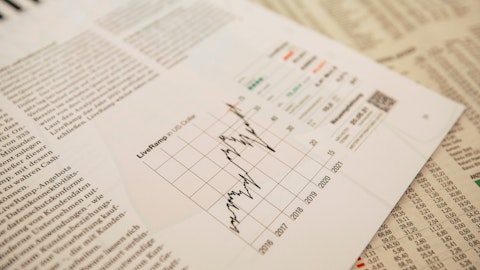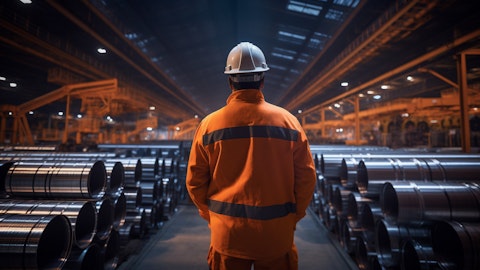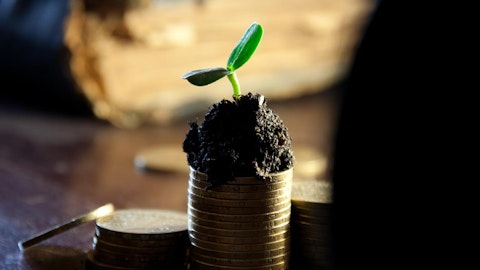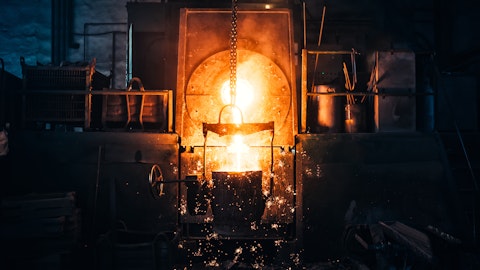Gerdau S.A. (NYSE:GGB) Q4 2023 Earnings Call Transcript February 21, 2024
Gerdau S.A. isn’t one of the 30 most popular stocks among hedge funds at the end of the third quarter (see the details here).
Renata Oliva Battiferro: Good afternoon, everyone. Welcome to Gerdau’s Earnings Release Call for the Fourth Quarter of 2023. My name is Renata, Head of Investor Relations, and participating in our video conference today are CEO of Gerdau, Gustavo Werneck, and CFO, Rafael Japur. We would like to inform you that this video conference is being recorded and will be available on the company’s IR website, where the complete material of the earnings release is available. You can also download the presentation using the chat icon. We would like to remind you that the broadcast of this video conference is being done with simultaneous translation through the tool available in the platform. To access the feature, just click on the Interpretation button via the globe icon at the bottom of the screen and choose your preferred language, Portuguese or English.
For those of you listening to the video conference in English, there is an option to mute the original audio in Portuguese by clicking on Mute original audio. During the company’s presentation, all participants will have their microphones disabled. Following the presentation, we will begin the Q&A session. Analysts and investors can send their questions in advance via chat and can also open their camera if they prefer during the Q&A session. We wish to emphasize that the information contained in this presentation and any other statements that may be made during the video conference concerning Gerdau’s business prospects, projections, and operating and financial goals are based on the beliefs and assumptions of the company’s management as well as information currently available.
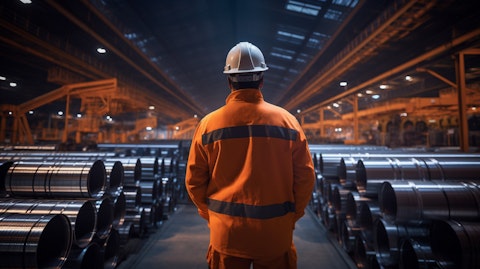
Forward-looking statements are no guarantee of performance. They involve risks, uncertainties, and assumptions because they relate to future events and therefore, depend on circumstances that may or may not occur. Investors should understand that general economic conditions, market conditions and other operating factors may affect Gerdau’s future performance and lead to results that differ substantially from those expressed in such forward-looking statements. I will now turn the floor to Gustavo Werneck to initiate the presentation. Gustavo, you may proceed.
Gustavo Werneck: Hello, everyone. I hope you’re well and thank you for the opportunity to meet on this video conference to announce Gerdau’s results for the fourth quarter of 2023. I’m joined by our CFO, Rafael Japur, and for both of us, it’s always a pleasure to talk to you about our performance and also to clarify any issues that may arise during our presentation. I will start by talking about the macro business environment, the highlights of the overall results, and right after that, I will detail the performance of our business operations in the quarter. Next, Japur will then share some information about our financial performance. Finally, I will highlight some points from our sustainability agenda, and we will then move on to our Q&A session.
On this second slide, I would like to highlight that we ended 2023 with an injuries frequency rate of 0.70, which is the lowest rate ever recorded in our historical annual series, reinforcing our commitment to people’s health and safety. At Gerdau, safety always comes first, since no result is more important than people’s lives. Looking at the next three slides, I will highlight the growth in steel exports from China as the main factor impacting our business in the markets where we operate. China is currently going through a period of profound transformation in the pillars that have sustained its high economic growth in recent decades, especially the weakening of the infrastructure and residential construction sectors, which accounted for more than half of the country’s GDP growth in that period.
See also 13 Best Chinese Stocks To Buy Right Now and 13 Best Car Stocks To Buy Right Now.
Q&A Session
Follow Gerdau S A (NYSE:GGB)
Follow Gerdau S A (NYSE:GGB)
These two factors, very strong consumers of steel have lost relevance as levers of the Chinese economy, causing a deep and structural imbalance between steel supply and demand in the Chinese domestic market. With a policy of maintaining jobs, the Chinese government has subsidized surplus steel production, exporting these volumes at prices below production cost to countries that have not yet taken trade defense measures against unfair trade practices such as Brazil. Trade defense measures against predatory practices are legal and supported by the World Trade Organization. Not surprisingly, countries like the United States, Mexico, Turkey and the other 27 countries in the European Bloc have in recent months adopted relevant measures to combat the entry of subsidized Chinese steel at their borders, strengthening their economies, their industries, and also their jobs.
The chart on Slide 4 shows the shocking increase in the penetration of imported steel in Brazil over the course of 2023, a phenomenon still prevailing in the first months of 2024. The Brazilian government’s procrastination in following the aforementioned countries in implementing trade defense measures is already having a significant impact on the Brazilian’s steel producing sector and Gerdau’s operation in Brazil, with the shutdown of production capacities and the dismissal of hundreds of workers who have had their jobs in Brazil taken away in exchange for jobs in China. In the last week alone, as has been widely reported in the press, 100 people were laid off at our Pindamonhangaba plant. Those were highly trained and skilled people who could not continue their careers with us because we had to shut down more production lines in Brazil.
I will end by reinforcing that I personally and other Gerdau leaders have been saying for many years that we believe in open and free trade, that even in the face of difficulties of doing business in the country, due to the high Brazil cost, we have been able to compete on an equal shooting with any steel producer in the world. However, there is no chance of competing with the steel coming from countries in which governments support and subsidize illegal and predatory global trade practices. At a time when Gerdau is celebrating 123 years of history, maintaining annual investments in the order of R$6 billion, we once again appeal to the Brazilian federal government to quickly analyze this issue, thus preventing an industrial sector as relevant and strategic for the country as the steel sector is from being harshly penalized to the point of losing its future competitiveness.
Moving on to Slide 6, I will talk about the highlights of each of our business operations and the outlook for the coming months. Now moving to the next slide at the start of the first quarter of 2024 in the North America market has been marked by healthy levels of demand, with our backlog stable at a high level of 60 days. This scenario reflects the resilience of the U.S. economy, with U.S. GDP growing by 3.3% in the fourth quarter of 2023 when compared to the previous quarter, above previously published expectations. As a result, the country’s actual GDP is projected to have grown by 2.5% last year, compared to an increase of 1.9% in 2022. The U.S. market at the start of 2024 continues to reflect the measures taken by the local government, such as the Inflation Reduction Act, IRA, the reshoring movement, and the maintenance of Section 232.
I would also like to point out that we continue to invest in improving the operating efficiency of our North American BD units, with an emphasis on the plants in Midlothian in Texas and Jackson in Tennessee, ensuring that we offer a portfolio of steel products and services to our customers in the region and continuously generate value for our stakeholders. In Midlothian, the solar plant which we inaugurated in mid 2023 is operating at full capacity, bringing benefits to the operation as planned. Now moving to the next slide, I will now talk about our special steel BD. The automotive market in the U.S. continues to recover gradually, with the production of light and heavy vehicles projected to be above 16 million units in 2024 with normalized inventory levels.
There is still room, however, for a more intense recovery in the coming years, returning to pre-pandemic levels. In turn, the outlook for the special steel market in Brazil continues to be influenced by the uncertainties linked to access to credit lines and the acceleration in the reduction of interest rates, which continue to be high, contributing to a restriction in the demand for vehicles as well by the scenario of excessive entry of imported vehicles. Now going to the next slide, I will now talk about the long and flat steel scenario in Brazil, whose performance in the fourth quarter and for the whole of 2023 reflects a slowdown in our steel shipments on the domestic market, mainly due to the excessive entry of imports into the country as a result of predatory trade practices as I mentioned earlier.
Last year, steel imports increased by 50% compared to 2022, totaling 5 million tonnes, reaching a record volume in the annual historical series, according to the Brazil Steel Institute. I would also like to point out that in December the penetration rate in Brazil was over 25%. The steel sector in Brazil employs 3 million people, including direct, indirect and induced jobs, and a significant portion of these jobs remain at imminent risk in the face of this challenging short-term scenario. If prolonged for several more months, this situation will also contribute to the acceleration of the country’s deindustrialization process, which is already underway and poses a threat to the investments planned for the steel industry for the coming years.
Now, moving to the next slide, we will talk about the South America BD. I will start by saying that in order to focus on our asset optimization strategy and long-term growth, in January we sowed our operations in Colombia and the Dominican Republic. This divestment is in line with Gerdau’s capital allocation strategy, focusing on the growth and competitiveness of our assets, with the greatest potential for generating value in the long-term. In Argentina, for instance, inflationary pressure, import restrictions and the first measures taken by the new government, such as the devaluation of the Argentine peso, remains points of attention for the performance of the local market over the next few quarters. Uruguay scenario remains positive, reflecting good levels of steel consumption, particularly in the agribusiness sector and public and private investment.
In Peru, GDP rose slightly again in November after seven months of decline driven by the mining and fishing sectors. Construction activity remained stable, still impacted by delays in public works resulting from the climate events experienced by the country throughout the year. I will now hand over to Japur and afterwards, I’ll be back to talk about our ESG journey and also answer your questions.
Rafael Japur: Thank you, Gustavo. Hello everyone. It is always a great pleasure to be here with you once again for Gerdau’s earnings release presentation. We ended the fourth quarter of 2023 with EBITDA of R$2.39 billion and net sales of R$14.7 billion and a 14% margin. In addition to the typical seasonality of the period in our shipments both indicators, both EBITDA and net sales were impacted by the maxi-devaluation of their Argentine peso, which explains, respectively 40% reduction in EBITDA and 54% reduction in our net sales. Now moving to Slide 13, please. Let’s talk about our working capital. By the end of December, our working capital stood at R$14.2 billion, down 10% quarter-on-quarter. We saw improvements in all lines, with growth in accounts payable and reductions in both accounts receivable and inventories.
Even with these significant savings in working capital, cash conversion cycle increased to 87 days due to the 14% drop in net sales which we showed on the previous slide. With regard to free cash flow, Gerdau generated R$1.285 billion in Q4. Based on our EBITDA of R$2 billion, we had a relevant working capital release of R$1.279 billion, the largest release in the last 16 quarters. Regarding our CapEx between October and December, we spent R$1.540 billion in CapEx. Year-to-date, we generated free cash flow of R$7 billion equivalent to half the EBITDA for the period. Let’s now move to the next slide to talk about liquidity and our debt position. We ended the year with gross debt of R$10.892 billion. We still have an excellent level of leverage with a net debt over EBITDA ratio of 0.40x.
The chart on the right hand side of the page, we detail our liquidity in our debt amortization schedule. We ended Q4 with a robust available liquidity of R$9.5 billion considering the cash position of R$5.3 billion and the R$875 million of our revolving credit facility, or RCF, which is fully available and unused. Moving on to Slide 15, let’s talk about the return to our shareholders. Gerdau SA and Metalurgica Gerdau will pay dividends on March 12 and 13, respectively. Gerdau SA will pay R$0.10 per share, while Metalurgica Gerdau SA will pay R$0.05 per share. In both cases, shareholding positions as of March 1, 2024 will be taken into account. As a result, Gerdau SA will have paid out in 2023 more than R$2.6 billion, equivalent to 37% of our free cash flow, or 44% of our accounting net income for the year, well above the 30% set forth in our bylaws.
Moving to the chart on the right side of the slide, we detail total return to our shareholders between 2018 and 2023. Taking into account, dividends paid out buyback programs, and share appreciation of Gerdau. We had a return of well over 100% in the period reaffirming our commitment to consistently creating value for our shareholders. Now moving on to Slide 16. Our CapEx investment closed at approximately R$5.700 billion in 2023. This figure includes investments in both maintenance and competitiveness. Of this total, R$1.6 billion were earmarked for improving our environmental practices and improving the safety of our people and our operations in 2024. According to the material fact we released, we plan to invest R$6 billion in CapEx, around half of which in maintenance and the other half in competitiveness.
On the right hand side of the slide, we have highlighted five projects that will be our focus over the next few quarters. These are initiatives that we have already communicated to you on other occasions, which aim to guarantee our long-term competitiveness, focusing on the assets with the greatest potential for creating value. With regard to Gerdau Next, we invested R$524 million in 2023, mainly in the joint ventures Newave Energia and Addiante for 2024. We currently have planned investments of between R$100 million and R$200 million. Closing the CapEx section on Slide 17, we provide an update on the progress of Gerdau’s strategic CapEx of the R$11.9 billion to be invested by 2026, 36% has already been executed. In North America, we highlight the advances in rolling mills in Jackson and Petersburg, as well as the completion of the Whitby melt shop.
In Brazil, the expansion of the coiled hot rolled strips in the Ouro Branco mill is well underway and is expected to start operating in the fourth quarter of 2024. Finally, I would like to point out that we have a solid and robust balance sheet with low leverage, built up over the last few years through strict discipline in capital allocation. It is more than enough to support our investment plan. Even so, we are attentive to the future scenario and the context of our business, and if necessary, we will revise our strategic investment plan according to these variables. Once again, thank you very much for your attention and I’ll turn the floor back to Gustavo. I’ll come back at the end for the Q&A session.
Gustavo Werneck: Thank you, Japur. In the following slide, I’ll detail how we’ve made progress in our sustainability journey. Firstly, I’d like to highlight the fact that Gerdau has just achieved. An A- grade for the first time in the climate change module of the 2023 cycle of CDP, an organization that is a global benchmark for evaluating sustainable actions, with this evolution, we have achieved leadership status in the subject, surpassing the global average and that of the metals and metallurgy sector, reinforcing our commitment to transparency and to reducing greenhouse gas emissions. The learning journey provided by the CDP assessment is crucial for making decisions related to climate change. For Gerdau, achieving the leadership status in this module is proof that our strategy and our initiatives are progressing in line with our long-term planning.
Still on this topic and reinforcing the evolution of our sustainability journey, I would like to mention that Gerdau was selected for the third time to join the B3 Carbon Efficient Index, ICO2. The index brings together publicly traded companies committed to efficiency and transparency in the management of greenhouse gases. Lastly, I would like to highlight the laying of the cornerstone at the beginning of February for the Arinos’ solar farm in Minas Gerais as part of our commitment to expanding the generation of clean and renewable energy in our operations in Brazil. The Solar Mega Plant is an initiative of Newave Energia, a renewable energy platform, in which Gerdau holds a 33.33% stake through our new business division called Gerdau Next.
With an estimated total investment of around R$1.5 billion, the project is expected to be completed by the end of 2024 and will create approximately 4,000 direct and indirect jobs which will contribute to local income and development for decades to come. Well then, thank you, everyone, ladies and gentlemen for listening to our presentation and from now on we’ll be available to answer questions and perhaps drill down those points of interest to you. Thank you very much.

